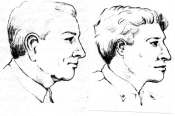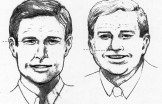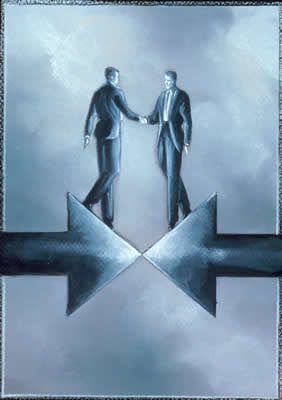If we call our eyes the "windows to the soul," then our ears are the "doors to our reality." Ears are just as important as our eyes for learning about our environment. Our ears take in information from all sides, including directions in which we are not looking. They are like antennas and depending on their size, shape and location they will reflect our personal reality. In face reading, ears reflect some of the most basic personality traits. The speed with which we make decisions, how long we listen before we shut down, whether we are visual and need to see what we are taking in, or our independence of thought and action are all qualities reflected by our ears.
As you may recall, last month we used the Newsletter to promote our two day workshop and I promised that this newsletter would return to the usual format. I have actually doubled the content discussing six aspects of the ears. Each section shows a contrast that can apply to ears. They can be large or small and high or low and stick out or be close to the head. Each possibility can be applied to each ear. On many people, both ears are not the same size, location or distance from the head. Be sure to notice these differences and apply the appropriate reading to their personal life (left side) or external life (right side).
|
|
|
Large and Small Ears
 Large ears: Your ears indicate kindness because you are willing to give your time and attention to listen to others. Your big ears make you a patient listener who is always willing to hear more. Your ears allow you to soak up information like a sponge. Be sure you nod your head from time to time so the person talking will know that you are truly listening. Large ears: Your ears indicate kindness because you are willing to give your time and attention to listen to others. Your big ears make you a patient listener who is always willing to hear more. Your ears allow you to soak up information like a sponge. Be sure you nod your head from time to time so the person talking will know that you are truly listening.
Theory: Large ears can be determined if no more than 3 of them can be stacked end to end on the side of the head. Ears are our antennas that take in information from all sides, including directions in which the person is not looking. With large antennas, a person is able to hear a lot and sustain their listening capability even if the person talking goes on and on.
Small ears: You are visually and experientially oriented and learn things best when you can see them. Making a list or keeping a pad by the phone is always a good idea. You relate what you hear to your own personal reality and consequently tend to trust your own internal council over what other people tell you. More often than not, you found this approach works better for you. The challenge with small ears is if the other person is stalling or dragging things out you may stop listening all together. Even if you are still smiling and nodding your head you have already moved on and now you are thinking about something else.
Theory: Small ears can be determined if 5 or more of them can be stacked end to end on the side of the head. When someone is trying to convey a message to a person with small ears, they need to be sure they have eye contact, show them the graphs and charts. Don't stall or drag things out for too long or the small eared person will stop listening. It is best if you can get the small eared person to write some of it down. For them the information seems to go straight from the eye to the brain. |
|
High and Low Ears
 High tops: You take in information very quickly and mentally process quickly. You don't have to be told twice because you got it the first time. (Coupled with high eyebrows) You may get information overload. (Coupled with low eyebrows) You can me mentally intimidating because your brain works so fast that you are having ten thoughts while the other person is trying to express one. You have a "let's get it done", "let's do it now" attitude. You want to see the results. Your challenge is that once something is no longer a problem you may erase your mental hard drive and not remember the trivia. High tops: You take in information very quickly and mentally process quickly. You don't have to be told twice because you got it the first time. (Coupled with high eyebrows) You may get information overload. (Coupled with low eyebrows) You can me mentally intimidating because your brain works so fast that you are having ten thoughts while the other person is trying to express one. You have a "let's get it done", "let's do it now" attitude. You want to see the results. Your challenge is that once something is no longer a problem you may erase your mental hard drive and not remember the trivia.
Theory: When the tops of the ears are above an imaginary line drawn horizontally through the middle of the eyes, they have high ears. This person is very quick on the uptake and hates stalling.
Low bottoms: You gather information carefully to get things right. You prefer wisdom over speed. You refuse to be rushed because you don't want to miss something. It is a type of carefulness in listening that is similar to a perfectionsit. You want to be sure you get it right. (Coupled with high eyebrows
) You are an excellent strategist, developing long term carefully thought out plans. (Coupled with low eyebrows
) You may be too hard on yourself since you want things perfect and right now too.
Theory: When the lobes are below an imaginary line drawn horizontally below the nose the person has low ears, They want to be careful about what they hear and will take the time to get things right.
|
|
Stick out & Close Ears

Stick out: You are independent and non-conformist and do things your own way. You are a natural self-starter because you see what needs to be done and you may jump in and do it. If you have to work with others, it would be helpful if you occasionally say something like," Oh, I see what you mean or I see what you are saying." After they walk away you may want to go ahead and do it you way. However it will make them feel like they were included. You never feel compelled to do, act or think like everyone else. In fact, your independence is an essential part of your self image.
Theory: The more that a person's ears stick out from their head, the more independent and non-conformist they are. They listen to and trust their own perception and are not impressed with consensus reality. They would never do something because " that is the way you are suppose to do it." Actions based solely on the unexamined idea of standard convention does not impress them. Ross Perro is particularly notable for this feature.
Close to head: You are a conformist. You have a strong desire to belong and "fit in." You don't want to be too weird, odd or different.
You accept society's norms and have no difficulty going along with them. You notice when someone is out of step with the traditional code of conduct, manners, dress, or behavior. One of your strengths is marketing because you identify with the bell-curve of humanity and therefore know what most people like.
Theory: Only read those ears that are very close to the head or definitely stand out. Be aware of the fact that the ears might not match and one ear may stick out more than the other. For example, a person can be more independent or non-conformist in their personal life (left ear) while they abide by the rules in their business life (right ear) .
|
|
The Do's and Don'ts In Reading the Ears
During the two days of the workshop I received several insights from the participants. They reminded me of the many challenges confronting a novice face reader. I must admit that after reading thousands of faces over more than 20 years, I sometimes forget what it was like for me in the beginning. Ears are important but they can be a bit more challenging to read than some of the other features.
The size of ears is proportional to the head. As I have noted earlier in this newsletter, you can take the ear size and stack it on the side of the head to help you determine if the ear is large or small. A much better way to do it is just look at the ear and then listen to your reaction. "Oh my gosh, he has elephant ears" or "those ears are about as big as sea shells". If you don't have either of these reactions, it is a non-read and you can go on to something else.
The biggest challenge for beginners is trying to determine if a person has high ears or low ears. As for the height of an ear, you need to be sure that the person has their chin level with the floor. If their chin is either up or down, or they have their head cocked to the side it will definitely skew the high or low reading. If the tops are much higher than the eye, then read "high ears." If the bottoms are much lower than the nose, then read "low ears".
If the ear is both above the eye and below the base of the nose, read "large ears." I
f you have any doubt, just skip it and go on to something more definite.
When you look at someone's face straight on and you cannot even tell they have ears, then read "ears close to head". If they stick out so far you are reminded of a taxi cab with both doors hanging open, then read "stick out ears." Otherwise, skip it.
The place where face reading loses its accuracy is when the feature being read is average. The biggest mistake I see with beginning face readers is their attempt to read an average feature and force it into a category. If the feature is neither high nor low, big or small, in or out but somewhere in the middle, don't read it.
Even if you guess right, It will not be as accurate a read since the defining qualities are found in the extremes. The things you could see from even across the room will be a much better guide and give you a more accurate reading than anything you have to guess at. Beginners often think being a good face reader is being able to see tiny hidden nuances on the face. However, the best face readers go after the obvious features and they skip average features.
|
|
Speaking of the website, it is intended to be a place to "hang out". Please take a look.
Thank you for your interest. I welcome your comments, questions and observations. You can e-mail me directly at
[email protected]
or my business partner,
Your feedback is valuable. My goal is to develop and use Amazing Face Reading as a tool to see everyone more clearly and compassionately. I really believe we can understand every person we meet on a deeper level.
Kind regards,
Mac
Mac Fulfer
Amazing Face Reading |
|
|

IFA Workshop
On September 23rd and 24th the International Factoring Association held an Amazing Face Reading Workshop at the Gaylord Resort and Convention Center in Grapevine, Texas. The program was a huge success and we received some of the highest ratings ever awarded to an IFA sponsored workshop.
Both Ann Marks and I were overjoyed with the participation of each attendee. We promised them that they could begin reading faces before the workshop was over. By the end of the program each one was able to give a full, spot-on face reading. We were delighted.
We also had time to apply the tool of face reading to the dynamics of sales and hiring. Overall, it was an amazing experience for all involved.
We are now offering this two day workshop as an option to organizations around the world. If you are interested or know someone that might be, please call me at 817-336-3445 or e-mail: [email protected].
|
|
|
|
|